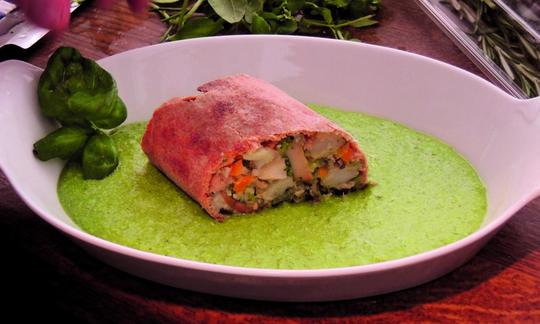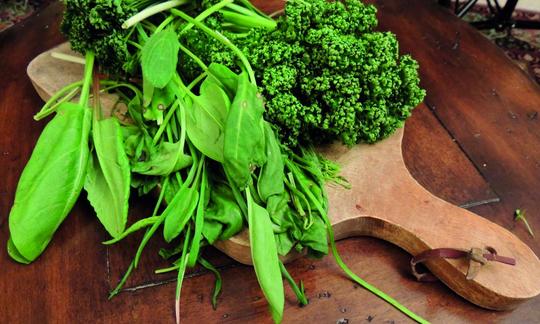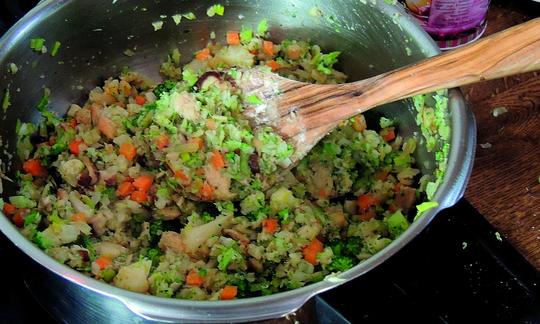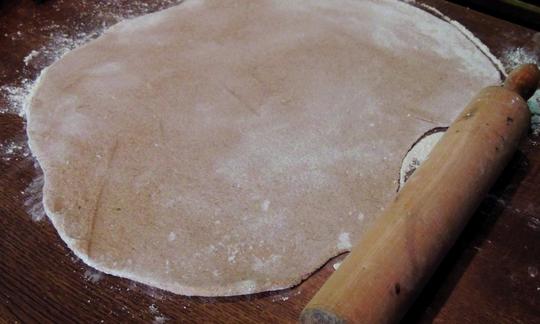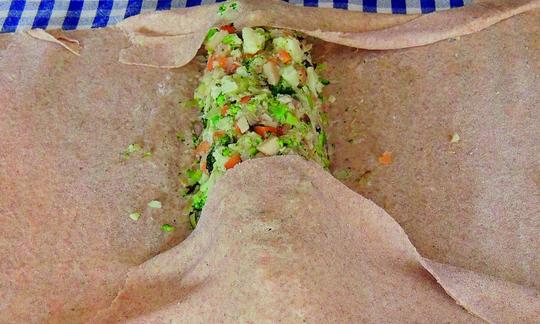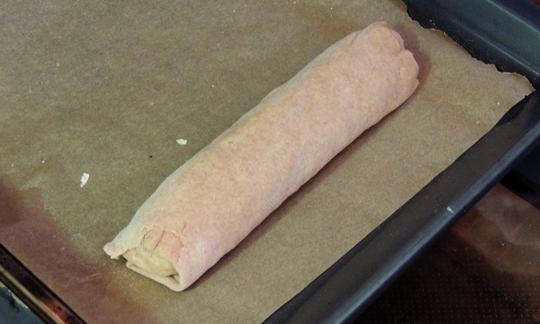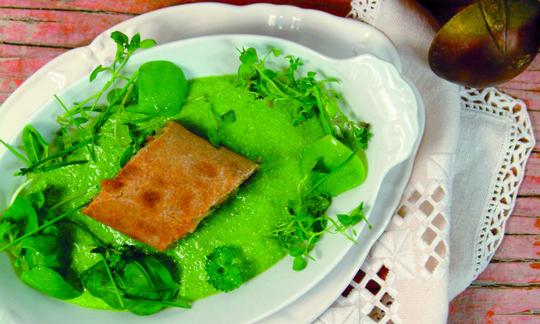Vegetable Strudel with Frankfurt Green Sauce
vegan
Ingredients (for servings, )
Equipment
- blender
- food processor
- rolling pin
- skillet (frying pan)
- stove
- citrus juicer (lemon squeezer)
- mezzaluna
- oven
- baking sheet (cookie sheet)
Type of preparation
- cook
- fry
- bake
- chop or grind
- blend
- squeeze
- sweat
- meld
- season to taste
- remove the skin
- roll out
- knead
Preparation
For the cashew cream
Place the cashews and water in a blender and blend to a creamy consistency. Remove 100 ml of the cashew cream for the strudel dough. Set the remaining cream aside for the Frankfurt green sauce.You can make more cashew cream if you want a larger quantity of sauce or if you want the consistency to be a bit thinner. You will need approximately 100 ml of cashew cream for the strudel dough, which is about ¼ of the total amount.
For the vegetable strudel
Heat the water. Combine the whole grain flour, lukewarm water, salt, and ¼ of the reserved cashew cream. Mix until the dough achieves a smooth consistency. Place on a warm plate and cover with a bowl to retain the warmth and keep it from drying out. Set the dough aside to rest for at least 30 minutes. In the meantime, continue with the next step.For this step, the author uses ½ tsp of a mixture that is 30 % vegetable and herb based and combined with untreated rock salt.
Clean the vegetables. Cut the broccoli and cauliflower into florets. Cut the mushrooms into thin slices. Slice the leek into rings and julienne the carrots. Peel and chop the onions. Sauté the onions and vegetables in oil and season generously with the spices. Remove from the heat, drain, and set aside to cool.
For a recipe that makes four servings, the author uses 500 grams (1 pound) of vegetables. You can decide how much of each vegetable you want to use. We have replaced the olive oil called for in the original recipe with canola oil and reduced the amount of oil from 2–3 tablespoons to 1 tablespoon. Garlic is an optional ingredient, and the recipe does not specify an amount.
Roll the dough out into a thin rectangle. Spread the vegetable mixture out evenly over the dough. Fold the sides of the dough in toward the middle and then roll up the strudel.
Place the strudel on a baking sheet lined with parchment paper and bake at 180 °C (350 °F) for 30 minutes.
While the strudel is baking, you can prepare the Frankfurt green sauce.
For the Frankfurt green sauce
Wash and mince the herbs. Squeeze the juice from the lemon and combine it with the reserved cashew cream (from Step 1), the mustard, and oil.The author did not specify any amounts for the herbs. You can decide for yourself how much you want to use. Season to taste. You can use more or less cashew cream, depending on the consistency you prefer.
We have replaced the sunflower oil with canola oil and reduced the amount of oil for four servings from 2 tablespoons to 1 tablespoon.
Fold the herbs into the cream until the sauce achieves a green color (for this, the herbs must be finely minced). Season with salt and pepper.
Arrange and serve
Spoon the Frankfurt green sauce (“Gree Soss”) onto plates and then place the slices of vegetable strudel on top. Serve.
|
Nutritional Information per person
Convert per 100g
|
2000 kcal | |
|---|---|---|
| Energy | 626 kcal | 31.3% |
| Fat/Lipids | 31 g | 44.0% |
| Saturated Fats | 4.8 g | 23.8% |
| Carbohydrates (inc.dietary fiber) | 76 g | 28.0% |
| Sugars | 9.5 g | 10.5% |
| Fiber | 13 g | 50.7% |
| Protein/Albumin | 22 g | 44.5% |
| Cooking Salt (Na:199.1 mg) | 506 mg | 21.1% |
| Essential micronutrients with the highest proportions | per person | 2000 kcal | |
|---|---|---|---|
| Min | Manganese, Mn | 3.6 mg | 181.0% |
| Min | Copper, Cu | 1.6 mg | 164.0% |
| Vit | Vitamin K | 101 µg | 135.0% |
| Prot | Tryptophan (Trp, W) | 0.29 g | 118.0% |
| Vit | Vitamin C (ascorbic acid) | 77 mg | 97.0% |
| Min | Iron, Fe | 13 mg | 90.0% |
| Prot | Threonine (Thr, T) | 0.82 g | 88.0% |
| Elem | Phosphorus, P | 579 mg | 83.0% |
| Elem | Magnesium, Mg | 265 mg | 71.0% |
| Prot | Valine (Val, V) | 1.2 g | 71.0% |
Detailed Nutritional Information per Person for this Recipe
The majority of the nutritional information comes from the USDA (US Department of Agriculture). This means that the information for natural products is often incomplete or only given within broader categories, whereas in most cases products made from these have more complete information displayed.
If we take flaxseed, for example, the important essential amino acid ALA (omega-3) is only included in an overarching category whereas for flaxseed oil ALA is listed specifically. In time, we will be able to change this, but it will require a lot of work. An “i” appears behind ingredients that have been adjusted and an explanation appears when you hover over this symbol.
For Erb Muesli, the original calculations resulted in 48 % of the daily requirement of ALA — but with the correction, we see that the muesli actually covers >100 % of the necessary recommendation for the omega-3 fatty acid ALA. Our goal is to eventually be able to compare the nutritional value of our recipes with those that are used in conventional western lifestyles.
| Essential fatty acids | per person | 2000 kcal |
|---|---|---|
| Linoleic acid; LA; 18:2 omega-6 | 6.0 g | 60.0% |
| Alpha-Linolenic acid; ALA; 18:3 omega-3 | 0.73 g | 37.0% |
| Essential amino acids | per person | 2000 kcal |
|---|---|---|
| Tryptophan (Trp, W) | 0.29 g | 118.0% |
| Threonine (Thr, T) | 0.82 g | 88.0% |
| Valine (Val, V) | 1.2 g | 71.0% |
| Isoleucine (Ile, I) | 0.87 g | 70.0% |
| Phenylalanine (Phe, F) | 1.1 g | 69.0% |
| Leucine (Leu, L) | 1.6 g | 64.0% |
| Lysine (Lys, K) | 0.92 g | 50.0% |
| Methionine (Met, M) | 0.36 g | 39.0% |
| Vitamins | per person | 2000 kcal |
|---|---|---|
| Vitamin K | 101 µg | 135.0% |
| Vitamin C (ascorbic acid) | 77 mg | 97.0% |
| Folate, as the active form of folic acid (née vitamin B9 and | 131 µg | 66.0% |
| Vitamin A, as RAE | 517 µg | 65.0% |
| Thiamine (vitamin B1) | 0.66 mg | 60.0% |
| Vitamin B6 (pyridoxine) | 0.65 mg | 46.0% |
| Pantothenic acid (vitamin B5) | 2.1 mg | 36.0% |
| Niacin (née vitamin B3) | 5.4 mg | 34.0% |
| Biotin (ex vitamin B7, H) | 17 µg | 34.0% |
| Vitamin E, as a-TEs | 3.7 mg | 31.0% |
| Riboflavin (vitamin B2) | 0.30 mg | 21.0% |
| Vitamin D | 0.05 µg | 1.0% |
| Vitamin B12 (Cobalamin) | 0.01 µg | < 0.1% |
| Essential macroelements (macronutrients) | per person | 2000 kcal |
|---|---|---|
| Phosphorus, P | 579 mg | 83.0% |
| Magnesium, Mg | 265 mg | 71.0% |
| Potassium, K | 1'260 mg | 63.0% |
| Sodium, Na | 199 mg | 25.0% |
| Calcium, Ca | 162 mg | 20.0% |
| Essential trace elements (micronutrients) | per person | 2000 kcal |
|---|---|---|
| Manganese, Mn | 3.6 mg | 181.0% |
| Copper, Cu | 1.6 mg | 164.0% |
| Iron, Fe | 13 mg | 90.0% |
| Zinc, Zn | 5.9 mg | 59.0% |
| Selenium, Se | 14 µg | 26.0% |
| Iod, I (Jod, J) | 13 µg | 9.0% |
| Fluorine, F | 65 µg | 2.0% |
This vegetable strudel with whole grain spelt flour and cashew cream on Frankfurt green sauce contains no animal products but still tastes incredibly delicious.
Frankfurt green sauce: Classic Frankfurt green sauce is made with seven herbs, usually parsley, chervil, borage, sorrel, cress, salad burnet, and chives. It is traditionally served on Holy Thursday and then until the first frost in the fall, but the herbs are at their best in May.
Red sorrel: Red sorrel can be found growing on meadows and the edges of fields. You can harvest them year-round, and they have a slightly sour taste. Red sorrel contains high levels of vitamin C but also oxalic acid. If you have a sensitivity, consuming too much red sorrel can irritate the mucous membranes in the intestinal tract. However, it is safe to eat in the amounts called for in this recipe.
Dill: While fresh dill tips have the best flavor, all parts of the young plant that are above ground can be used. Dill contains essential oil with carvone as the main component.
Borage — Warnings: Borage contains liver-toxic and carcinogenic pyrrolizidine alkaloids, which is why the German Federal Institute for Risk Assessment (BfR) does not recommend consuming it. Some other countries strictly regulated its use — for example, in Belgium, borage has not been authorized for consumption since 1997. Adults may be able to consume it in small quantities (approx. 2 g of herb mixtures containing borage); however, it should be noted that your total consumption may be additionally increased if you eat or drink other foods such as herbal tea or honey. To be on the safe side, you can replace borage in recipes with dill or lemon balm.
You can find out more by clicking on the ingredient borage.
Spelt flour: Spelt flour is closely related to wheat and is often referred to as “proto-wheat.” It is classified by type number according to the amount of mineral content in 100 grams. Spelt flour can be purchased as type 630, 812, and 1050. The higher the type number, the more nutrient dense and healthier the spelt flour. Spelt flour is also available in whole grain form. Type 630 works well for making baked goods, and it can often be used as a substitute for wheat flour. Types 812 and 1050 have a higher mineral content. The differences between spelt and wheat are negligible when it comes to nutritional content. Compared to wheat, spelt does contain much higher levels of silica.
Cashews: There is hardly another food that contains a higher proportion of the essential amino acid tryptophan than cashews. Tryptophan is an essential nutrient in the production of the neurotransmitter serotonin. Cashews are also a good source of minerals such as magnesium and iron. However, cashews cannot be eaten raw because they contain the toxic oil cardol. When sold commercially, they have either been steamed or roasted and are therefore not truly raw. If “Raw cashews” is on the label, this usually just means that the toxic cardol they contain has been deactivated by steaming instead of roasting. It is only when the process is explained in detail and controlled that we can be sure the cashews are raw.
Reducing salt and oil: We have intentionally reduced the amount of salt. The goal is to keep the salt content as low as possible without sacrificing flavor. Since the amount of salt required varies by individual, it is best for you to decide on the amount to use. We have also reduced the amount of oil. We recommend the book Salt Sugar Fat by Michael Moss, which provides interesting insight into this topic.
Canola oil: Instead of the olive oil called for in the recipe, we recommend that you use canola oil as canola oil has a better ratio of omega-6 (LA) to omega-3 fatty acids (ALA). As a comparison, olive oil has an LA:ALA ratio of 11–12:1 whereas the ratio of the two fatty acids for canola oil comes in just over 2:1.
Harvesting herbs: If you enjoy gathering and harvesting ribwort plantain, the best time to do so is from the beginning of April through the end of August. You can often find it in small meadows, in fields, and on the edges of pastures. Red sorrel often grows in meadows and at the edges of fields and can be harvested year-round. You should be cautious when gathering wild dill as it can be easily confused with poisonous hemlock.
Other herbs: In place of the herbs called for in the recipe, you can also use the seven classic herbs (see Notes).

